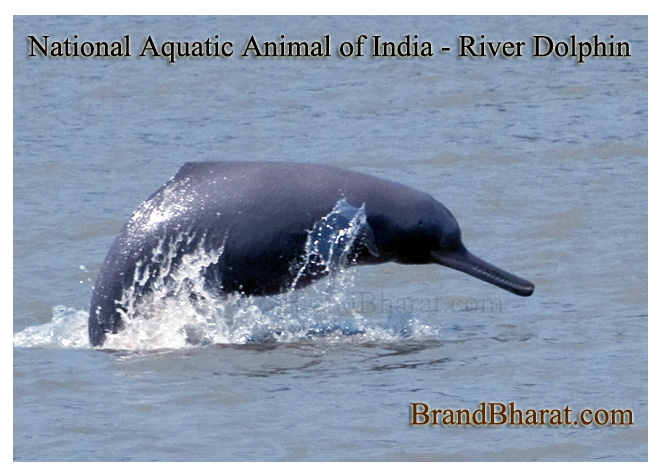

भारत का राष्ट्रीय जलीय पशु - डॉल्फिऩ

River Dolphin is the National Aquatic Animal of India. The Ministry of Environment and Forests notified the Ganges River Dolphin as the National Aquatic Animal on 18th May 2010. This mammal is also said to represent the purity of the holy Ganga as it can only survive in pure and fresh water. Platanista gangetica has a long pointed snout and also have visible teeth in both the upper and lower jaws. Their eyes lack a lens and therefore function solely as a means of detecting the direction of light. Dolphins tend to swim with one fin trailing along the substrate while rooting around with their beak to catch shrimp and fish. Dolphins have a fairly thick body with light grey-brown skin often with a hue of pink. The fins are large and the dorsal fin is triangular and undeveloped. This mammal has a forehead that rises steeply and has very small eyes. River Dolphins are solitary creatures and females tend to be larger than males. They are locally known as susu, because of the noise it makes while breathing. This species inhabits parts of the Ganges, Meghna and Brahmaputra rivers in India, Nepal, Bhutan and Bangladesh, and the Karnaphuli River in Bangladesh. River dolphin is a critically endangered species in India and therefore, has been included in the Schedule I for the Wildlife (Protection) Act, 1972. The main reasons for decline in population of the species are poaching and habitat degradation due to declining flow, heavy siltation, construction of barrages causing physical barrier for this migratory species.
मीठे पानी की डॉलफिन भारत का राष्ट्रीय जलीय जीव है। पर्यावरण और वन मंत्रालय ने राष्ट्रीय एक्वाटिक पशु के रूप में 18 मई 2010 को गंगा नदी डॉल्फिन अधिसूचित (पीडीएफ फाइल जो नई विंडों में खुलती है) किया। यह स्तनधारी जंतु पवित्र गंगा की शुद्धता को भी प्रकट करता है, क्योंकि यह केवल शुद्ध और मीठे पानी में ही जीवित रह सकता है। प्लेटेनिस्टा गेंगेटिका नामक यह मछली लंबे नोकदार मुंह वाली होती है और इसके ऊपरी तथा निचले जबड़ों में दांत भी दिखाई देते हैं। इनकी आंखें लेंस रहित होती हैं और इसलिए ये केवल प्रकाश की दिशा का पता लगाने के साधन के रूप में कार्य करती हैं। डॉलफिन मछलियां सबस्ट्रेट की दिशा में एक पख के साथ तैरती हैं और श्रिम्प तथा छोटी मछलियों को निगलने के लिए गहराई में जाती हैं। डॉलफिन मछलियों का शरीर मोटी त्वचा और हल्के भूरे-स्लेटी त्वचा शल्कों से ढका होता है और कभी कभार इसमें गुलाबी रंग की आभा दिखाई देती है। इसके पख बड़े और पृष्ठ दिशा का पख तिकोना और कम विकसित होता है। इस स्तनधारी जंतु का माथा होता है जो सीधा खड़ा होता है और इसकी आंखें छोटी छोटी होती है। नदी में रहने वाली डॉलफिन मछलियां एकल रचनाएं है और मादा मछली नर मछली से बड़ी होती है। इन्हें स्थानीय तौर पर सुसु कहा जाता है क्योंकि यह सांस लेते समय ऐसी ही आवाज निकालती है। इस प्रजाति को भारत, नेपाल, भूटान और बंगलादेश की गंगा, मेघना और ब्रह्मपुत्र नदियों में तथा बंगलादेश की कर्णफूली नदी में देखा जा सकता है। नदी में पाई जाने वाली डॉलफिन भारत की एक महत्वपूर्ण संकटापन्न प्रजाति है और इसलिए इसे वन्य जीवन (संरक्षण) अधिनियम, 1972 में शामिल किया गया है। इस प्रजाति की संख्या में गिरावट के मुख्य कारण हैं अवैध शिकार और नदी के घटते प्रवाह, भारी तलछट, बेराज के निर्माण के कारण इनके अधिवास में गिरावट आती है और इस प्रजाति के लिए प्रवास में बाधा पैदा करते हैं।

Bihar became the first state in India to have separate web page for every city and village in the state on its website www.brandbihar.com (Now www.brandbharat.com)
See the record in Limca Book of Records 2012 on Page No. 217